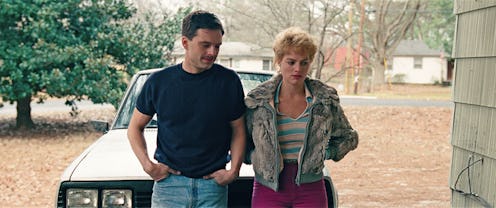Entertainment
Why 'I, Tonya' Only Shows Tonya Harding's Side Of The Nancy Kerrigan Attack

What really happened between figure skaters Tonya Harding and Nancy Kerrigan in 1994? With so much chaos surrounding the infamous attack on Kerrigan, it's impossible to know for sure, which makes judging how accurate I, Tonya is a challenge. But, then again, that's by design. I, Tonya, the new movie that covers Harding's rise to international glory and subsequent fall from grace isn't exactly based on true events, but rather on multiple versions of the same events.
In 1994, Kerrigan was attacked during a practice for the U.S. Championships — the main event leading up to the Winter Olympics. Kerrigan was, at the time, largely considered the best ice skater in the U.S., but since she was unable to compete due to injury, it was Harding who ended up taking the Championship that year. It was later revealed that Harding's ex husband, Jeff Gillooly, had hired someone to attack Kerrigan to throw the competition to Harding. People went to jail, and Harding eventually admitted to impeding the investigation, but she has always denied knowing about the attack before it happened. Still, she was consequently stripped of her titles and kicked out of the U.S. Figure Skating Association.
The story has, for decades, been lost in a sea of tabloid fodder and America's obsession with pitting women against one another. Needless to say, any definitive version of the "truth" has never been established, but I, Tonya tells Harding's side of the story, if not Kerrigan's.
"There's no such thing as truth. Everyone has their own truth," says Tonya (Margot Robbie) in the I, Tonya trailer. This quote perfectly describes I, Tonya's commitment to telling the "true" story of Harding. Instead of looking for one version of events, screenwriter Steven Rogers looked for two: one from Harding's perspective and another from Gillooly's. The finished project is told from these two point of views, with multiple versions of events.
To write the script, Rogers went directly to the source, first reaching out to Harding and interviewing her. He spent two days with the former Olympic athlete before tracking down Gillooly. After meeting Gillooly and interviewing him, Rogers found something surprising: the exes' stories rarely matched up, not even the details of their first date were consistent. "Their stories were so wildly different, they didn't remember anything the same," Rogers told the LA Times at the Toronto International Film Festival. It was this discord that inspired the final script, and prompted I, Tonya to open with a title card that reads, "Based on irony free, wildly contradictory, totally true interviews with Tonya Harding and Jeff Gillooly."
A majority of I, Tonya is based on the real recollections of Harding and Gillooly, but there was also creative liberty taken, specifically with the character of Harding's mother, LaVona Golden, as played by Allison Janney. When researching for the script, Rogers was unable to track Golden down. Harding had been estranged from her mother for years, and, with only one video interview upon which to base her performance, Janney approached the character with a fair amount of freedom. "We didn't know at the time if she was alive or dead, so it was pretty much Tonya's experience of her mother and artistic license," Janney said at a Deadline event.
Despite being a movie about a highly publicized event, with multiple first person accounts, I, Tonya isn't really any more accurate than any other biopic. What it is, however, is more honest about it's inaccuracies. No movie can be 100 percent accurate because no one's memory is 100 percent accurate. Harding and Gillooly both have their own version of events, and both are valid. How accurate their memories are isn't really something an audience can judge. So, how accurate is I, Tonya? It's impossible to tell, but that's kind of the point.